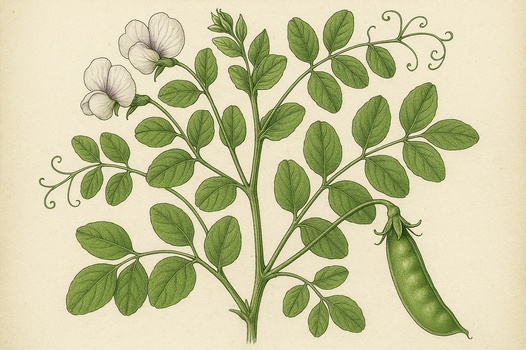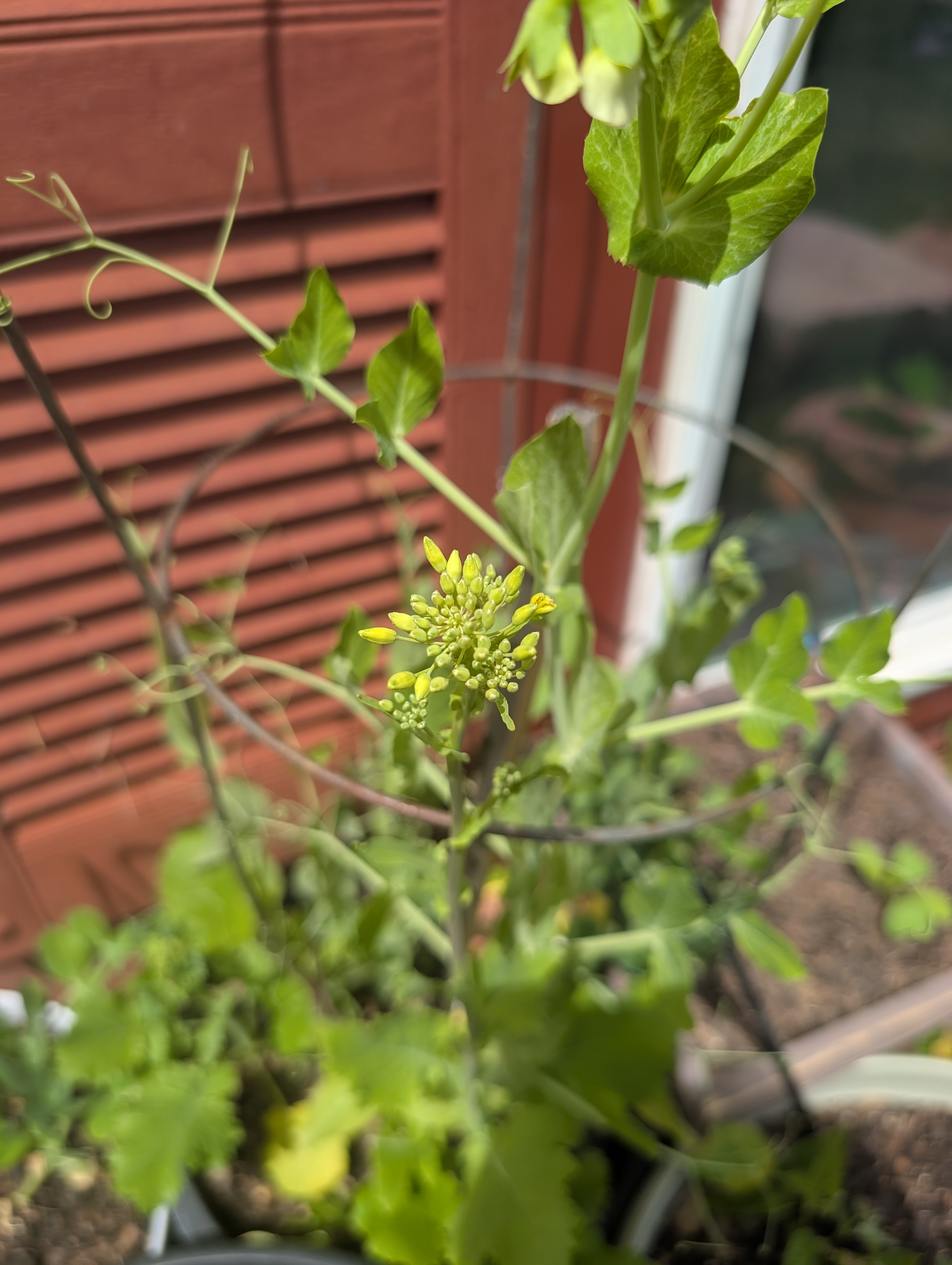| gen: 2025/05/20 : 14:58 in 1 min 10.0 secname: Moth |
| type: thingscientific name: Eudocima materna |
| pts: 0confidence level: 90% |
It is a Moth. Scientific name: Eudocima materna. This is a large moth with a unique wing pattern that resembles a snake's head, which serves as a defense mechanism against predators. The wings are typically greenish with brown edging and a distinct yellow eye-spot that looks like a snake's eye. The body is robust, with a brownish or greenish color.. Some moths in the Eudocima genus are known for their fruit-piercing abilities, sometimes causing damage to crops.. The moth's position and wing patterns create an illusion of a snake's head, a common defense strategy. The color and shape of the wings are characteristic of the Eudocima genus.
| gen: 2025/05/17 : 20:21 in 1 min 12.0 secname: Garden Pea |
| type: thingscientific name: Pisum sativum |
| pts: 0confidence level: 85% |
It is a Garden Pea. Scientific name: Pisum sativum. The garden pea is a vining plant with delicate rounded green leaves comprised of multiple leaflets. It produces tendrils at the leaf tips used for climbing. The plant exhibits small cluster inflorescences of bilateral symmetry flowers that are typically white or light purple. Stems are smooth and are capable of producing pods containing multiple green seeds.. Garden peas are one of the oldest cultivated crops, dating back to 8000 B.C, and have been a staple in diets and agriculture since then.. The structure of the leaves and the presence of tendrils indicate a vining plant typical of the pea family. The arrangement of the leaves and the blooming inflorescence are consistent with garden peas. The characteristics visible, such as the yellow emerging flowers and tendril structure, help narrow it down.
| gen: 2025/05/07 : 16:13 in 1 min 14.7 secname: Mustard Greens |
| type: thingscientific name: Brassica juncea |
| pts: 0confidence level: 90% |
It is a Mustard Greens. Scientific name: Brassica juncea. Mustard greens have large, broad leaves with a slightly serrated margin. They appear vibrant green with a crinkled texture. The plant grows in an upright rosette form and can reach up to 30 cm in height. The veins are prominent and the petioles are sturdy, often slightly ribbed.. Mustard greens are rich in vitamins A, C, and K, and they have been used in traditional cuisines for their peppery flavor.. The broad leaves with serrated edges and visible veins match the characteristics of Brassica juncea. The upright growth and texture of the leaves further support this identification.
| gen: 2025/04/27 : 19:22 in 59.6 secname: human |
| type: thingscientific name: Homo sapiens |
| pts: 2confidence level: 99% |
It is a human. Scientific name: Homo sapiens. Humans are bipedal primates characterized by their erect posture and bipedal locomotion. They have a large brain relative to body size, which allows for advanced cognitive abilities. The skin tone can vary widely between populations and individuals, and body hair is generally finer and sparser than in other primates.. Humans are the only species known to create complex languages and express themselves through art, music, and written text.. The image shows two people engaged in a martial arts pose, identifiable by their upright posture and distinctive human features such as limb proportions, facial structure, and lack of fur.
| gen: 2025/04/27 : 19:27 in 1 min 4.0 secname: Grape Hyacinth |
| type: thingscientific name: Muscari armeniacum |
| pts: 0confidence level: 95% |
It is a Grape Hyacinth. Scientific name: Muscari armeniacum. Grape hyacinth is a small, perennial, bulbous plant that bears dense clusters of small, bell-shaped blue flowers resembling clusters of grapes. The plants have slender, strap-like leaves that are green and grass-like. Each flower is typically a deep, rich blue with a slight musky scent.. Despite their common name, grape hyacinths are not true hyacinths; they belong to a different family, Asparagaceae.. The plant's flowers appear as dense clusters of tiny, bell-shaped blue blooms, which are characteristic of grape hyacinths. The narrow, grass-like leaves and spring blooming period also align with Muscari armeniacum's typical appearance and behavior.
| gen: 2025/04/26 : 19:34 in 1 min 3.6 secname: Aluminum ingot |
| type: thingscientific name: Aluminium (Al) |
| pts: 1confidence level: 95% |
It is a Aluminum ingot. Scientific name: Aluminium (Al). The object appears to be a small ingot or cast piece made of aluminum. It is metallic with a silvery appearance and has a smooth texture. The shape is irregular, which is typical of small-scale casting processes. The object sits on a rough wooden block.. Aluminum is the most abundant metal in the Earth's crust, and it's known for being lightweight and resistant to corrosion.. The object’s metallic luster, color, and casting marks are indicative of aluminum, a lightweight metal with a bright silvery appearance. Its placement on a wooden surface is consistent with a display for metal samples or small sculptures.
| gen: 2025/04/26 : 18:38 in 1 min 5.7 secname: Aluminum |
| type: thingscientific name: Al |
| pts: 0confidence level: 95% |
It is a Aluminum. Scientific name: Al. Aluminum is a silvery-white, lightweight metal. It has a low density and is malleable, making it suitable for a wide range of applications. Aluminum does not rust and is known for its remarkable ability to resist corrosion due to a thin surface layer of aluminum oxide that forms when it is exposed to air.. Aluminum is one of the most abundant metals in the Earth's crust, yet it was once considered a precious and valuable material due to the complexities involved in its extraction before modern methods were developed.. The object appears to be metallic with a distinctive silvery sheen and lightweight appearance, which are characteristic properties of aluminum. Its smooth, non-rusting surface suggests a metal resistant to corrosion, matching aluminum’s traits.
| gen: 2025/04/26 : 03:34 in 1 min 2.3 secname: Egg Tart |
| type: thingscientific name: N/A |
| pts: 0confidence level: 90% |
It is a Egg Tart. Scientific name: N/A. An egg tart consists of a pastry crust filled with egg custard, which is a mixture of eggs, sugar, milk, and sometimes vanilla. The top is typically browned, either naturally during baking or with a blowtorch to create a caramelized effect. The texture of the custard is smooth and creamy, while the crust is flaky and buttery.. Egg tarts are popular in several countries, with the most famous versions being the Portuguese pastel de nata and the Hong Kong-style egg tart.. The image shows small tart-like pastries with a caramelized topping, which are characteristic of egg tarts. The size, shape, and appearance of the filling match the typical characteristics of egg tarts.
| gen: 2025/04/25 : 16:28 in 1 min 1.2 secname: Garden Pea |
| type: thingscientific name: Pisum sativum |
| pts: 0confidence level: 95% |
It is a Garden Pea. Scientific name: Pisum sativum. The garden pea is a climbing annual plant with hollow, trailing stems, tendrils for climbing, and compound leaves with several oval leaflets. The plant produces white to purplish flowers, which are followed by green, pod-like fruits containing several seeds (peas). The stems and leaves are light green with a smooth texture, while the tendrils spiraling from the stems are thinner and more wiry.. Garden peas are one of the oldest cultivated crops, originating in the Mediterranean region and Western Asia. They were even found in ancient Egyptian tombs as symbols of prosperity.. The plant has the characteristic features of a pea plant, such as the compound leaves with multiple leaflets and tendrils for climbing. The pods and the distinct shape of the leaves help to confirm its identity as Pisum sativum.
| gen: 2025/04/24 : 00:58 in 1 min 6.8 secname: House Finch |
| type: thingscientific name: Haemorhous mexicanus |
| pts: 0confidence level: 95% |
It is a House Finch. Scientific name: Haemorhous mexicanus. The House Finch is a small bird with a conical-shaped beak adapted for seed eating. The male typically has bright red plumage on the head, chest, and rump, while females are generally brown and streaked. Both genders have brown wings and tails. The finch is small to medium-sized, with a long, slightly curved tail.. House Finches were originally native to the western United States and Mexico but have expanded their range across North America, largely due to human activities.. The bird exhibits the characteristic features of a House Finch, such as the red coloring and streaked brown pattern on the wings. The shape of the beak and the size are consistent with that of a finch.
| gen: 2025/04/23 : 23:25 in 60.0 secname: Fictional Character (Female Warrior) |
| type: thingscientific name: N/A |
| pts: 0confidence level: 100% |
It is a Fictional Character (Female Warrior). Scientific name: N/A. A stylized depiction of a female warrior, clad in dark, ornate armor with horn-like features on the head. The armor includes metallic details and a flowing cape. She holds a staff with a glowing magical aura, suggesting magical abilities. Her stance is assertive, embodying strength and confidence.. Fictional characters like this are often seen in video games, graphic novels, and tabletop role-playing games, where they serve as avatars or personas for players.. The image shows an illustrated character with fantasy elements such as armor, horns, and a magical staff, typically seen in fantasy or role-playing games and media. Not representing a real-life organism or mineral.
| gen: 2025/04/23 : 15:52 in 49.5 secname: House Finch |
| type: thingscientific name: Haemorhous mexicanus |
| pts: 0confidence level: 95% |
It is a House Finch. Scientific name: Haemorhous mexicanus. The House Finch is a small bird characterized by a conical seed-eating bill, a moderate-length notched tail, and a relatively long wingspan. Males typically have red plumage on their heads and breasts, but this can vary to orange or yellow depending on diet. Females and juveniles are brown-streaked. Their song is a cheery warble, often with a 'chirp' note.. House Finches were originally native to the western United States but were introduced to the eastern U.S. in the 1940s, and they have since spread throughout the continent.. The bird's size, shape, and markings match those of a House Finch, especially the streaked underparts and the red-orange coloration on the head and throat area typical in males. These features, along with its habitat in urban and suburban areas, align well with the House Finch.
























